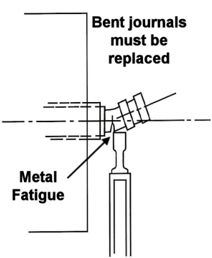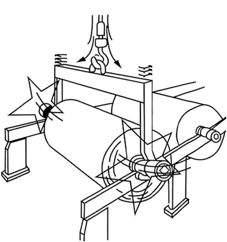Never straighten bent reel spool journals - safer to replace them
Mar 10, 2020
Reel spools carry more load for their size than any other roll in the paper mill. Because spool journals are more highly stressed than other rolls and are subjected to a fatigue stress, a hazardous situation may develop should they become bent. Bent journals can break, causing the log to fall from the reel or storage reels onto the floor and bump into equipment and personnel.

Figure 1. Replace bent reel journals.
Valmet recommends the following practices and precautions:
Bent reel spool journals must be replaced (Figure 1). Metal fatigue occurs in a bent reel spool journal due to residual stress. As the spool revolves, the fatigue becomes greater. When the reel spool bends, the metal becomes work hardened, making the journal brittle at the fatigue point, resulting in notch sensitivity. When this occurs, the journal can break.
Bent journals must never be straightened. Journals subjected to fatigue stresses will not tolerate yielding. Three problems are created in straightening the journal: First, it is impossible to straighten a journal without overloading the head. Second, in straightening the journal, the headfit may be lost. Third, if the journal could be straightened, it would probably creep back 20 to 30% due to residual stresses.
Care should be taken to prevent stress raisers. Due to notch sensitivity of metals in fatigue, a stress raiser can be detrimental. Some common causes of stress raisers are:
- Punch or chisel marks on fillet radii due to improper bearing removal.
- Scored crane pickup areas from picking up rotating spools.
- Dents or scrapes from mishandling.
Slowly lower jumbo logs into storage stands or unwind (Figure 2). Journal failures can easily be caused by lowering jumbo logs too quickly with the mill crane. An impact load may cause both bent journals and journal failures.

Figure 2. Handle paper logs with care.
All replacement journals should be 4340 heat treated steel. Journal replacement steel should be ordered to ASTM Spec: A434 class Bd. This specification gives the chemical composition, heat treating procedure and mechanical properties required for replacement journals.
Replacement journals should have polished fillet radii. When new journals are machined, care should be taken to obtain the proper fillet radii and all radii should be polished. Since fillet radii are areas of high stress concentration, tool marks are detrimental.
In all cases, personnel must stay clear of logs being transferred by crane or logs in motion on storage rails. Warnings are to be given when a log is being transferred by crane from storage rails to the winding station. Because of the massive weight of paper rolls, they must be handled with caution.
For more information on improving safety on your machine line, read other Up & Running articles on safety and consult with your Valmet representative.